My favorite part of being a part of MobLab is working directly with instructors, hands down. For the past 4 years I’ve been fortunate to meet with hundreds of instructors at conferences, Zoom meetings (it is what it is), and on campus. MobLab tends to attract instructors who are incredibly passionate about their students’ learning experience - and whether or not an instructor decides to use MobLab, it is insightful to hear about a wide variety of teaching methods. This past month, I had the opportunity to go on-campus at a large university in the Midwest to train a cohort of 18 Graduate Assistants (GAs) on the benefits of using experiments in the class, AND I must say, it feels refreshing to get back to the in-person workshops and meetings.
Since we had a good turn-out, I sought to create an interactive session where they assumed the role of students, and I simulated the role of instructor. This class had been using MobLab for several years. They are using MobLab in the recitation sessions with smaller groups - and the primary instructor wanted us to take a deeper dive into the Competitive Market game. The GAs wanted to have a member of the MobLab team come in to give some tips and pointers for how to spark conversation in class after the game has been played.
Our team has written other blog articles on similar topics such as Talking Through the Results, A Narrative Approach to the Competitive Market, and Presenting Results Sequentially. However, during this session, the goal was to explore ways to do ‘more’ with the results & post-game debrief. Therefore, I integrated some best practices and fun tips that I had picked up from other instructors using MobLab.
Prior to the session, I constructed my playlist with a few activities around the Competitive Market game. This was the GAs first exposure to MobLab, so I wanted to tell a story using gameplay. My playlist consisted of:
Open session survey 1 short practice round of the Competitive Market (1-minute) 2 rounds of the the Competitive Market with rotating roles (1:30 per round) 2 rounds of the Competitive Market with a Price Floor (1:30 per round)
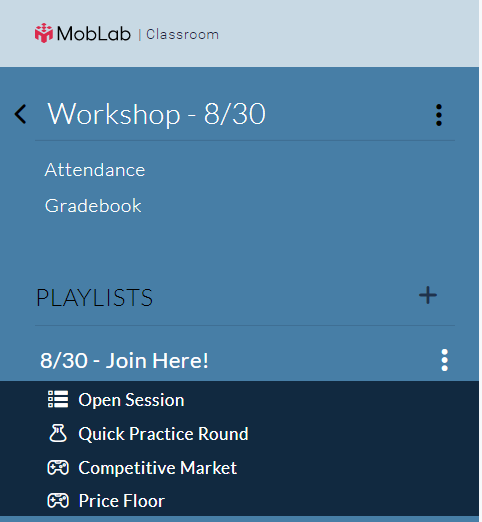
Workshop Playlist
The benefit of having a practice round was that it gave the GAs a bit of familiarity with the interface before our ‘actual game.’ I organized my playlist by naming each activity in a consistent manner, as seen in the figure above.
Then came the fun part….
Using the default configuration of the market game, I was able to have a quick view of the predicted outcome of the experiment given the Values (Demand Curve) and Costs (Supply Curve). Knowing these parameters and predicted equilibrium, I wrote my prediction for their market on a piece of paper, folded it and left it at the front of the class, untouched throughout and did not mention it (of course, nobody chose to sit at that front middle desk in a large classroom).
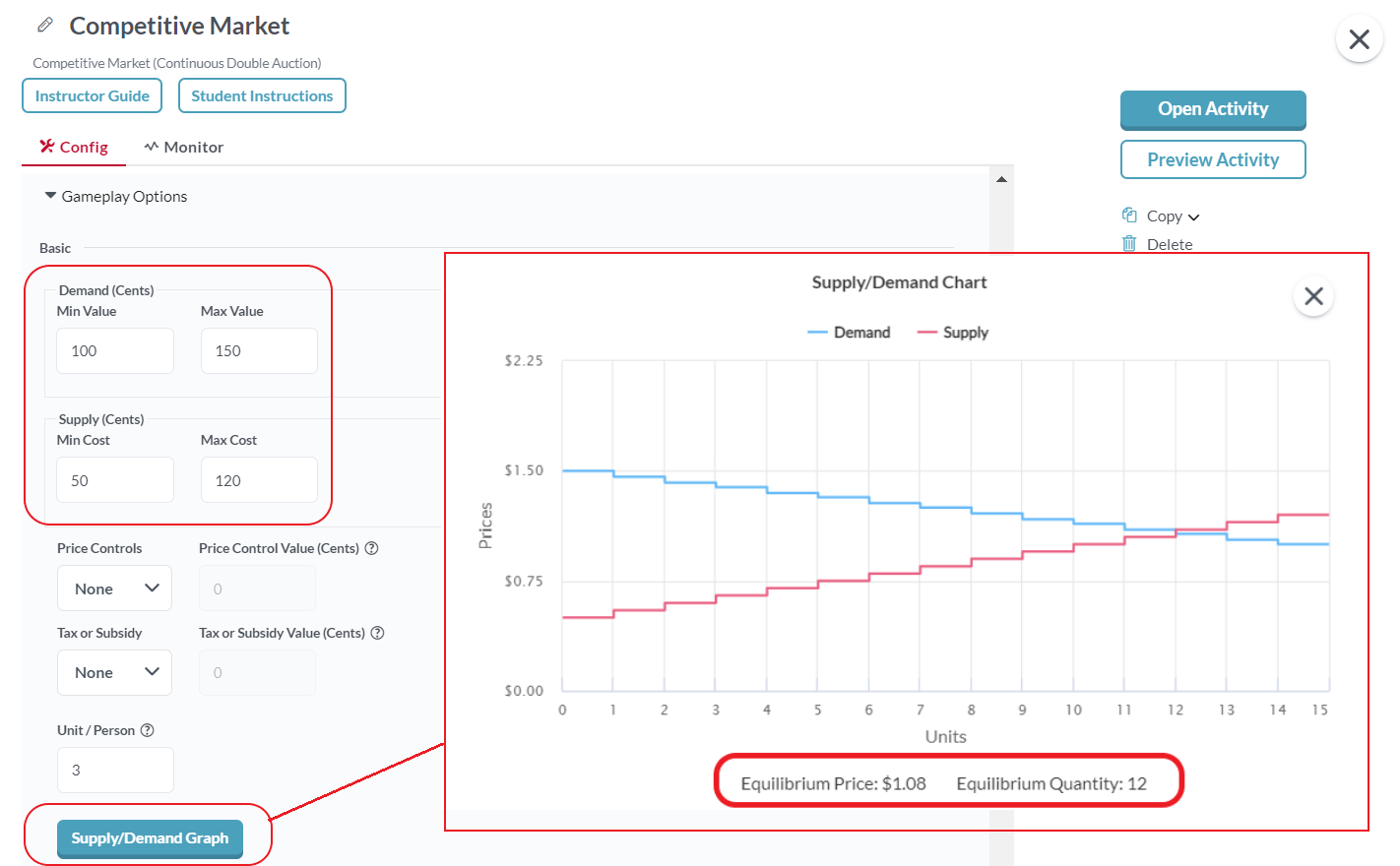
Instructors can set their demand & supply curve under the configurations tab of the Competitive Market Game
As a reminder, this was the GAs first exposure to MobLab. After the second round of the Competitive Market Game, I used the scoreboard feature to give a shoutout to the top three scores in the game. Finally, I posed the question “What do you think was the average price of an orange in this market?” A few eyes glazed over, uncertain about the answer - perhaps I should have used an in-class survey/poll to get some answers.
It was time for the big reveal, I walked over to the piece of paper and announced, “I’m not sure if you all noticed, but I deliberately placed this paper here. On it, I have marked down what I predicted the average price for this market, even before I started speaking today.”
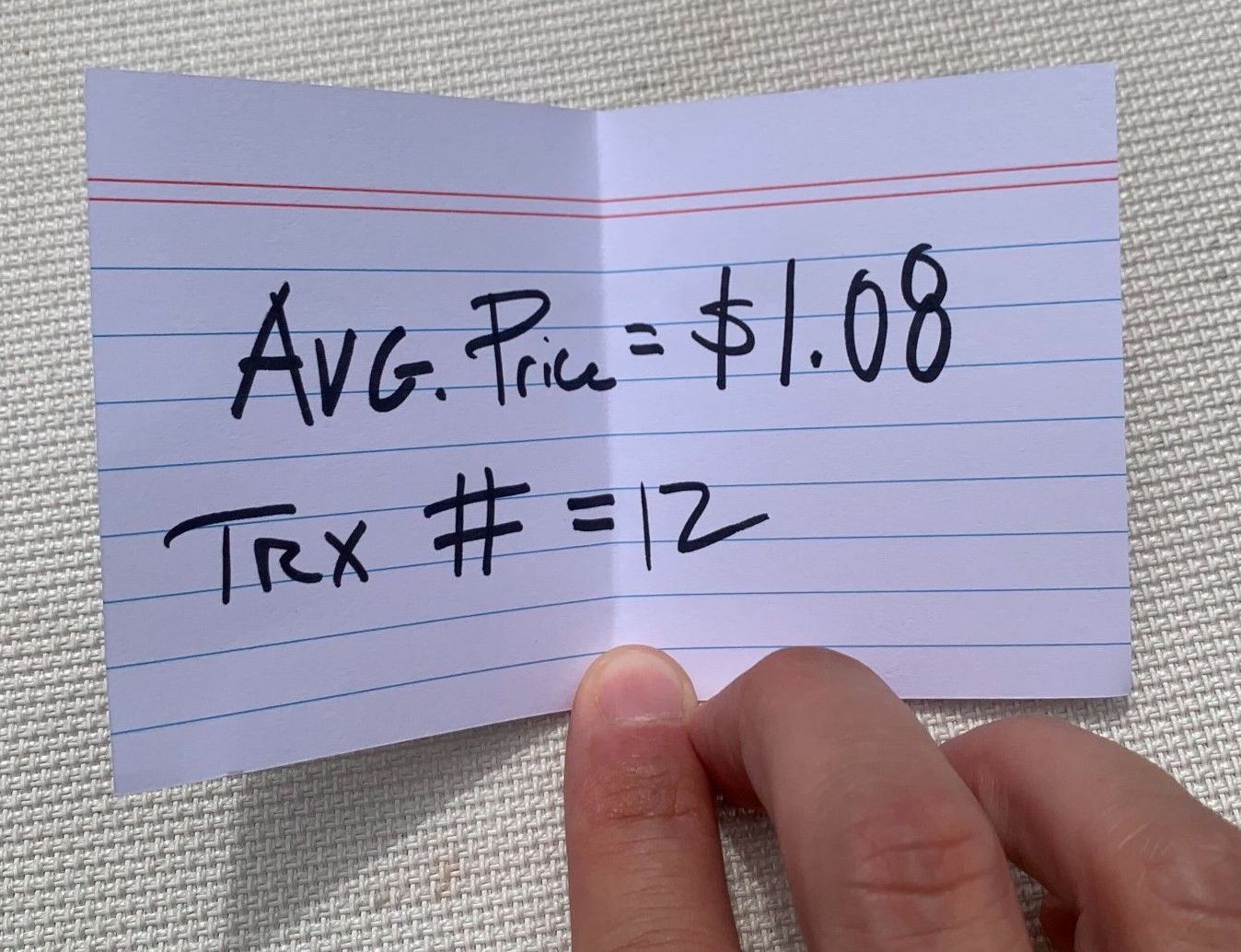
Predicted price in market
After I read out mine ($1.08), I opened up their results to show their average price of $1.05. Only $.03 off my prediction! The GAs lit up with smiles! It was a fun moment for everyone involved. I moved on to say that this is simply the invisible hand at work. In their Principles of Microeconomics course, they will cover markets, and how markets are an efficient way to allocate goods - and this fun example is no different.


Results Table showing the Equilibrium at the top, and the Average Price of the market on the bottom.
After winning back their attention, if just for the moment, I wanted to reiterate that we were trying to ‘tell a story’ using these games. Students will engage with a narrative approach to these games - rather than simply moving on post gameplay.
I moved on to the next activity, the same market but with a price floor. I wanted to have the game and results show just how stark of a difference, a simple configuration change can impact the market outcome.
It also becomes more impactful when students experience that transition. Showing the results of a market with a price floor only hits home when comparing it to a market with no intervention. Conveniently, MobLab has a Compare button on the results screen. Thus, I was able to show a side by side view of the markets.

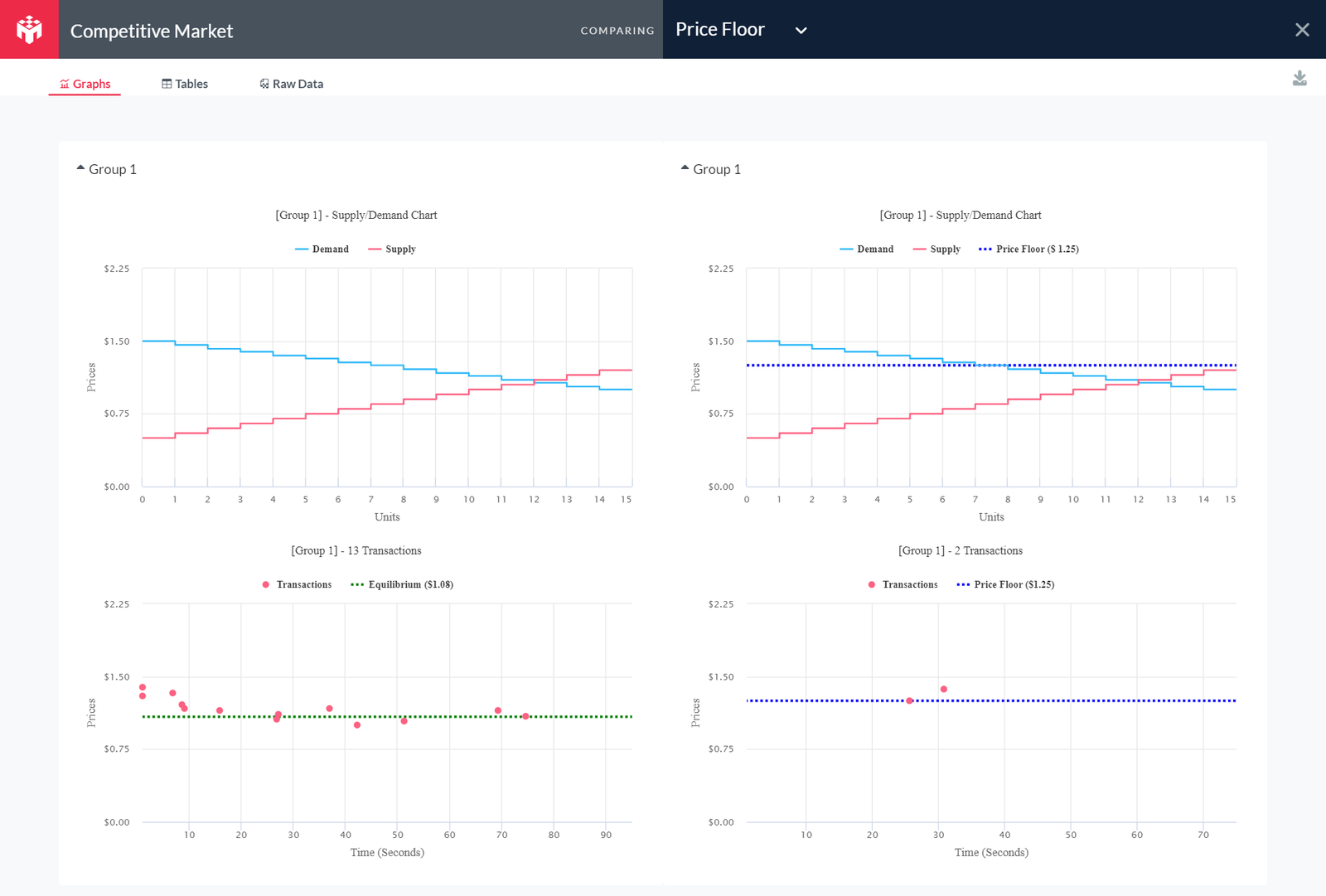
Market with no intervention (left) compared to a market with a price floor (right).
Following this game, I did have a quick in-class survey queued up as a comprehension check. To our delight, all of the GAs answered this question correctly.
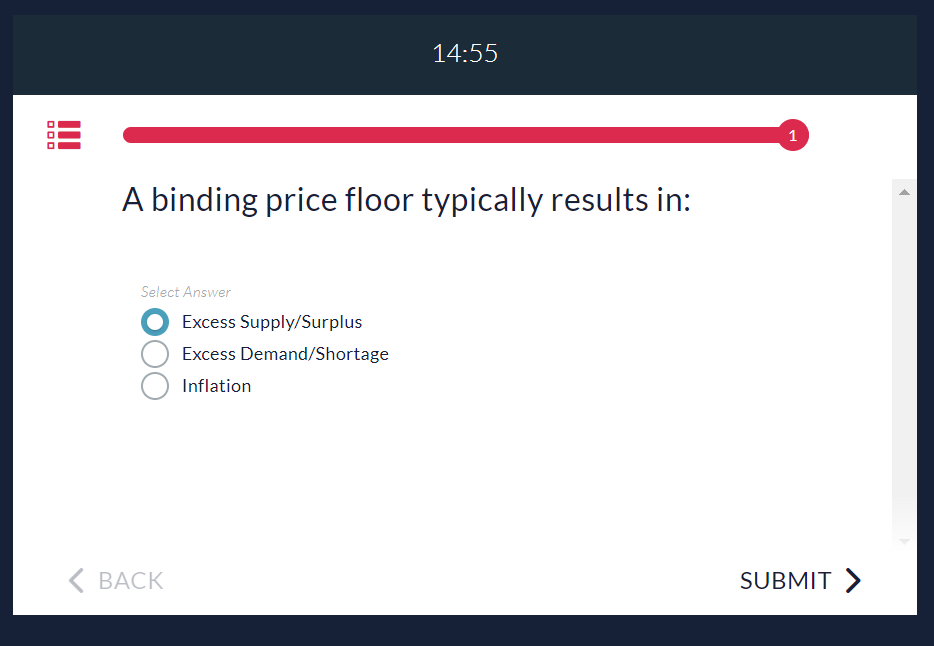
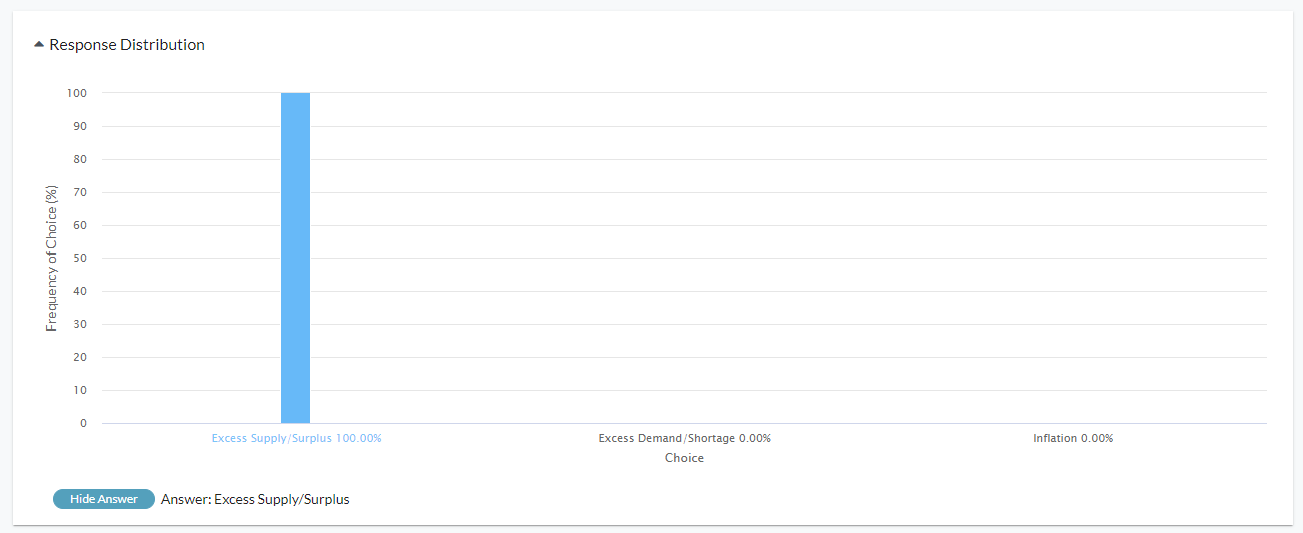
After the post-game survey - we wrapped up with our session!
It was a fun 45-minute session that got some laughs and engagement. Most importantly, the GAs got the opportunity to see a different approach than just running a game and looking at the results. We were able to bring some fun into how we analyze markets and use the student data as a way to reinforce the topics that are taught.
In addition, using an organized naming convention, we took students through different parameters of the same game. We experienced how a change in a parameter (such as a policy intervention) can have a profound impact on a market.
It was a fun experience, and I cannot wait to be back there next summer. I must say, it feels wonderful to be back in-person demonstrating the value of experiments and MobLab economics games.
To learn more, get in touch with our team. We’re happy to help. Click here to schedule a one-on-one demo meeting.
Since we had a good turn-out, I sought to create an interactive session where they assumed the role of students, and I simulated the role of instructor. This class had been using MobLab for several years. They are using MobLab in the recitation sessions with smaller groups - and the primary instructor wanted us to take a deeper dive into the Competitive Market game. The GAs wanted to have a member of the MobLab team come in to give some tips and pointers for how to spark conversation in class after the game has been played.
Our team has written other blog articles on similar topics such as Talking Through the Results, A Narrative Approach to the Competitive Market, and Presenting Results Sequentially. However, during this session, the goal was to explore ways to do ‘more’ with the results & post-game debrief. Therefore, I integrated some best practices and fun tips that I had picked up from other instructors using MobLab.
Prior to the session, I constructed my playlist with a few activities around the Competitive Market game. This was the GAs first exposure to MobLab, so I wanted to tell a story using gameplay. My playlist consisted of:

Workshop Playlist
Then came the fun part….
Using the default configuration of the market game, I was able to have a quick view of the predicted outcome of the experiment given the Values (Demand Curve) and Costs (Supply Curve). Knowing these parameters and predicted equilibrium, I wrote my prediction for their market on a piece of paper, folded it and left it at the front of the class, untouched throughout and did not mention it (of course, nobody chose to sit at that front middle desk in a large classroom).

Instructors can set their demand & supply curve under the configurations tab of the Competitive Market Game
It was time for the big reveal, I walked over to the piece of paper and announced, “I’m not sure if you all noticed, but I deliberately placed this paper here. On it, I have marked down what I predicted the average price for this market, even before I started speaking today.”

Predicted price in market


Results Table showing the Equilibrium at the top, and the Average Price of the market on the bottom.
I moved on to the next activity, the same market but with a price floor. I wanted to have the game and results show just how stark of a difference, a simple configuration change can impact the market outcome.
It also becomes more impactful when students experience that transition. Showing the results of a market with a price floor only hits home when comparing it to a market with no intervention. Conveniently, MobLab has a Compare button on the results screen. Thus, I was able to show a side by side view of the markets.


Market with no intervention (left) compared to a market with a price floor (right).


It was a fun 45-minute session that got some laughs and engagement. Most importantly, the GAs got the opportunity to see a different approach than just running a game and looking at the results. We were able to bring some fun into how we analyze markets and use the student data as a way to reinforce the topics that are taught.
In addition, using an organized naming convention, we took students through different parameters of the same game. We experienced how a change in a parameter (such as a policy intervention) can have a profound impact on a market.
It was a fun experience, and I cannot wait to be back there next summer. I must say, it feels wonderful to be back in-person demonstrating the value of experiments and MobLab economics games.
To learn more, get in touch with our team. We’re happy to help. Click here to schedule a one-on-one demo meeting.

